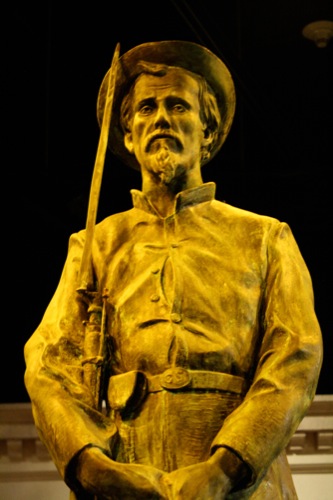
‘Gone With the Wind’
For many Americans, the most vivid images and stories related to Georgia and the Civil War are those they have seen or read in “Gone With the Wind.” Fans of the movie and book will want to include a visit to Jonesboro and the Road to Tara Museum on their tour of the Atlanta area.
“We’re the official home of ‘Gone With the Wind,’” said Rebekah Cline, marketing and comm unications director of the Clayton County Convention and Visitors Bureau. “We were designated by the Mitchell family in 1969.”
Although “Gone With the Wind” author Margaret Mitchell didn’t live in Jonesboro, she spent a lot of time visiting family members who lived in the area. Years after writing the book, she said many of the people that she met and the homes she saw in Jonesboro helped to inspire the novel.
Groups get a great overview of the area’s connection to the story at the Road to Tara Museum, which occupies a historic train depot in Jonesboro’s charming downtown. The museum has information about the Battle of Jonesboro, which took place as part of the Atlanta campaign, as well as exhibits detailing Mitchell’s time in town and numerous pieces of wardrobe and props from the making of the movie.
History at home
Though Sherman’s Union troops destroyed much of Atlanta and the surrounding area, not everything was burned. The village of Roswell remained largely intact after the Atlanta campaign and now has some of the area’s best examples of historic homes from the period.
“Roswell has three antebellum homes that are open for tours seven days a week,” said Marsha Saum, tourism sales manager at the Historic Roswell Convention and Visitors Bureau. “We call them the Southern Trilogy.”
The centerpiece of the trilogy is Bulloch Hall, a 7,000-square-foot plantation home built in 1839 by a prominent Roswell family. The home is considered one of the South’s best examples of temple-style Greek Revival architecture and features original paint colors, period furnishings and a number of slave cabins on the grounds. During the war, Union officers lived in the house while enlisted men camped on the grounds.
Another tour home, Barrington Hall, is notable for its antebellum garden. This large garden features the same varieties of botanicals the family would have planted in the 1830s and 1840s, positioned in the same beds and rows the original gardener designed.
The third piece of the trilogy, Smith Plantation, is a white wooden home with all original furnishings and 10 historic outbuildings.












